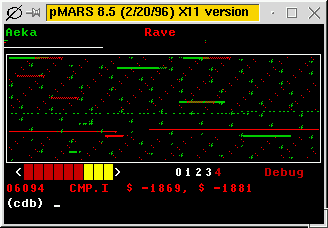Core War, a 1984 programming game that challenges players to create battle programs, or "warriors," written in the abstract assembly language called Redcode.

Gameplay:
At the heart of Core War, warriors compete for control of a virtual computer. Each program is loaded into memory at random locations, and the goal is to cause the processes of opposing programs to terminate by executing invalid instructions. Redcode instructions are at the core of this battle, with different versions of the language evolving over time.
Key Gameplay Features:
1. Constant instruction length and time.
2. Circular memory and relative addressing.
3. Low-level multiprocessing.
4. No external access to input or output functions.
5. Various versions of Redcode.
6. Strategies: Replicator, Scanner, Bomber, Vampire, Imp, Quickscanner, Core clear.
Redcode Programming:
Developing an effective warrior in Core War requires a deep understanding of strategies, and many programmers base their programs on existing warriors. Optimizers like OptiMax and core-step optimizer tools can help refine warriors. Additionally, genetic algorithms can be used to generate new strategies.
History:
Based in Darwin ( of Bell Labs in 1961, like Tron a 1982 film based on a similar concept ) Core War was inspired by self-replicating programs like Creeper and Reaper. The term "Core" in the name refers to magnetic-core memory. The first description of Redcode was published in 1984, and the International Core Wars Society (ICWS) played a crucial role in standardizing the language. Despite its defunct status, the ICWS's 1994 draft continues to serve as the de facto standard for Redcode.
Redcode Example:
To better understand Redcode, here's an example of ICWS-94 style Redcode:
```
0000: ADD.AB # 4, $ 3
0001: MOV.F $ 2, @ 2
0002: JMP.B $ -2, $ 0
0003: DAT.F # 0, # 0
```Addressing Modes:
Redcode supports various addressing modes, including immediate (#), direct ($), A-field indirect (*), B-field indirect (@), A-field indirect with predecrement ({), B-field indirect with predecrement (<), A-field indirect with postincrement (}), and B-field indirect with postincrement (>).
Creating a complete Redcode Corewar game requires a significant amount of code and explanation. Here's a simplified example to help you get started. Please note that this is a very basic representation, and real Corewar games are much more complex. Redcode is a low-level programming language used to create assembly programs for a virtual machine called the Memory Array Redcode Simulator (MARS).
```redcode
; Sample Redcode Corewar Game
; Two simple warriors that demonstrate basic concepts
; Warrior 1: A simple imp
ORG 0 ; Start at address 0
MOV 0, 1 ; Move instruction at address 0 to address 1
JMP -1 ; Jump to the previous instruction (infinite loop)
; Warrior 2: A simple scanner
ORG 100 ; Start at address 100
CMP 1, 1 ; Compare the contents of address 1 with itself
JMP -1 ; Jump to the previous instruction (infinite loop)```
This example includes two simple warriors: one that contains a simple imp, and another that acts as a scanner by repeatedly comparing its own instruction with itself. This is a minimalistic representation of a Corewar game.
To run this code, you'll need a Redcode simulator, such as pMARS, which allows you to create warriors, set the initial conditions, and simulate battles between them. Please consult the documentation for the specific Redcode simulator you are using to understand the rules and run this code.
References:
https://en.wikipedia.org/wiki/Core_Warhttps://vyznev.net/corewar/guide.htmlSome video of championships:
https://www.youtube.com/watch?v=-ytlji6T8R0https://www.youtube.com/watch?v=A8DPfQL3uO0&pp=ygUIY29yZXdhciA%3Dhttps://www.youtube.com/watch?v=HxFYva9lNzU&pp=ygUIY29yZXdhciA%3D
 Author
Topic: CoreWar (1984) Permanent Tournament of the most complex video game of history (Read 1063 times)
Author
Topic: CoreWar (1984) Permanent Tournament of the most complex video game of history (Read 1063 times)
